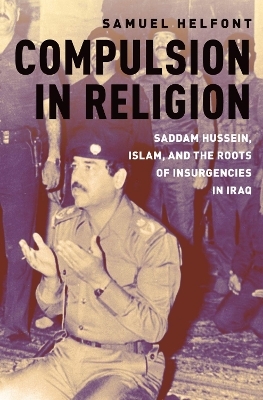
Compulsion in Religion
Oxford University Press Inc (Verlag)
978-0-19-760126-6 (ISBN)
The "Faith Campaign" Saddam launched during this period was the culmination of a plan to use religion for political ends, begun upon his assumption of the Iraqi presidency in 1979. At this time, Saddam began constructing the institutional capacity to control and monitor Iraqi religious institutions. The resulting authoritarian structures allowed him to employ Islamic symbols and rhetoric in public policy, but in a controlled manner. Saddam ultimately promoted a Ba'thist interpretation of religion that subordinated it to Arab nationalism, rather than depicting it as an independent or primary political identity.
The point of this examination of Iraqi history, other than to correct the current understanding of Saddam Hussein's political use of religion throughout his presidency, is to examine how Saddam's controlled use of religion was dismantled during the US-Iraq war, and consequently set free extremists that were suppressed under his regime. When the American-led invasion destroyed the regime's authoritarian structures, it unwittingly unhinged the forces that these structures were designed to contain, creating an atmosphere infused with religion, but lacking the checks provided by the former regime. Groups such as the Sadrists, al-Qaida, and eventually the Islamic State emerged out of this context to unleash the insurgencies that have plagued post-2003 Iraq.
Samuel Helfont is an Assistant Professor of Strategy and Policy in the Naval War College program at the Naval Postgraduate School in Monterey, California.
Preface and Acknowledgements
Introduction: Religion and Authoritarianism in Saddam's Iraq
Part I: The Penetration of Iraq's Religious Landscape 1979-1989
Chapter 1: Saddam Takes Control
Chapter 2: Co-opting and Coercing Religion in Saddam's Iraq
Chapter 3: Co-opting and Coercing Shi'ism
Chapter 4: Suppressing the Islamist Opposition
Chapter 5: Addressing the Limits of Coercion and Co-optation
Part II: The Gulf War and its Aftermath 1990-1993
Chapter 6: Continuity and Change in the Gulf War
Chapter 7: Iraq's Religious Landscape in the Wake of the Gulf War
Part III: The Faith Campaign 1993-2003
Chapter 8: A Transformed Religious Landscape
Chapter 9: The Regime and the Shi'is in the 1990s
Chapter 10: Mechanisms of Control
Chapter 11: Putting the System to Work
Part IV: The Invasion of Iraq War and the Emergence of Religious Insurgencies
Chapter 12: American Misconceptions about Iraq and the 2003 Invasion
Chapter 13: Emergence of Religious Insurgencies in Iraq
Conclusion: Saddam the Counter-Insurgent and other Reflections on Ruling Iraq
Notes
Bibliography
Index
| Erscheinungsdatum | 16.06.2021 |
|---|---|
| Verlagsort | New York |
| Sprache | englisch |
| Maße | 234 x 155 mm |
| Gewicht | 454 g |
| Themenwelt | Geisteswissenschaften ► Geschichte ► Regional- / Ländergeschichte |
| Geisteswissenschaften ► Religion / Theologie | |
| Sozialwissenschaften ► Politik / Verwaltung ► Europäische / Internationale Politik | |
| Sozialwissenschaften ► Politik / Verwaltung ► Politische Theorie | |
| ISBN-10 | 0-19-760126-X / 019760126X |
| ISBN-13 | 978-0-19-760126-6 / 9780197601266 |
| Zustand | Neuware |
| Haben Sie eine Frage zum Produkt? |
aus dem Bereich


